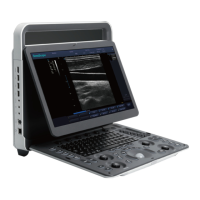6 Acquiring Images
Basic User Manual 81
1. Press the function key to select Gray Map.
2. Rotate the function key to adjust the value.
■ Compound Imaging
Compound imaging is used to acquire a series of overlapping image frames from
substantially differing spatial directions and combining these images to reduce speckle and
improve contrast resolution.
To use the compound imaging:
1. Press the function key to select Compound.
2. Rotate the function key to enable or disable the feature.
■ Line Density
Line density refers to the amount of ultrasound beam that makes up the image. Increasing
the value of line density improves the resolution and decreases frame rate. Therefore, you
have to balance the frame rate and the image quality when adjusting the line density.
A higher line density is useful in obtaining a very high resolution, such as the thyroid
or testicles. A lower line density is useful when scanning fetal heart beat, adult cardiac
applications and in clinical radiology applications.
To adjust the line density:
1. Press the function key to select Line Density.
2. Rotate the function key to adjust the settings.
■ Dynamic Range
Dynamic range increases the adjustable range of contrast by enhancing the intensities of
parts in the grayscale. It optimizes the ultrasound image texture.
To adjust the dynamic range:
1. Press the function key to select DR.
2. Rotate the function key to adjust the value.
■ Sector Width/Angle
Sector width (for linear probes) or sector angle (for curved and phased array probes)
is used to adjust the frame rate. You can adjust the sector width or angle to get more
information without moving the probe.
The region of interest of the object can be adjusted after you adjust the sector width or
sector angle.
To adjust the sector width/angle:

